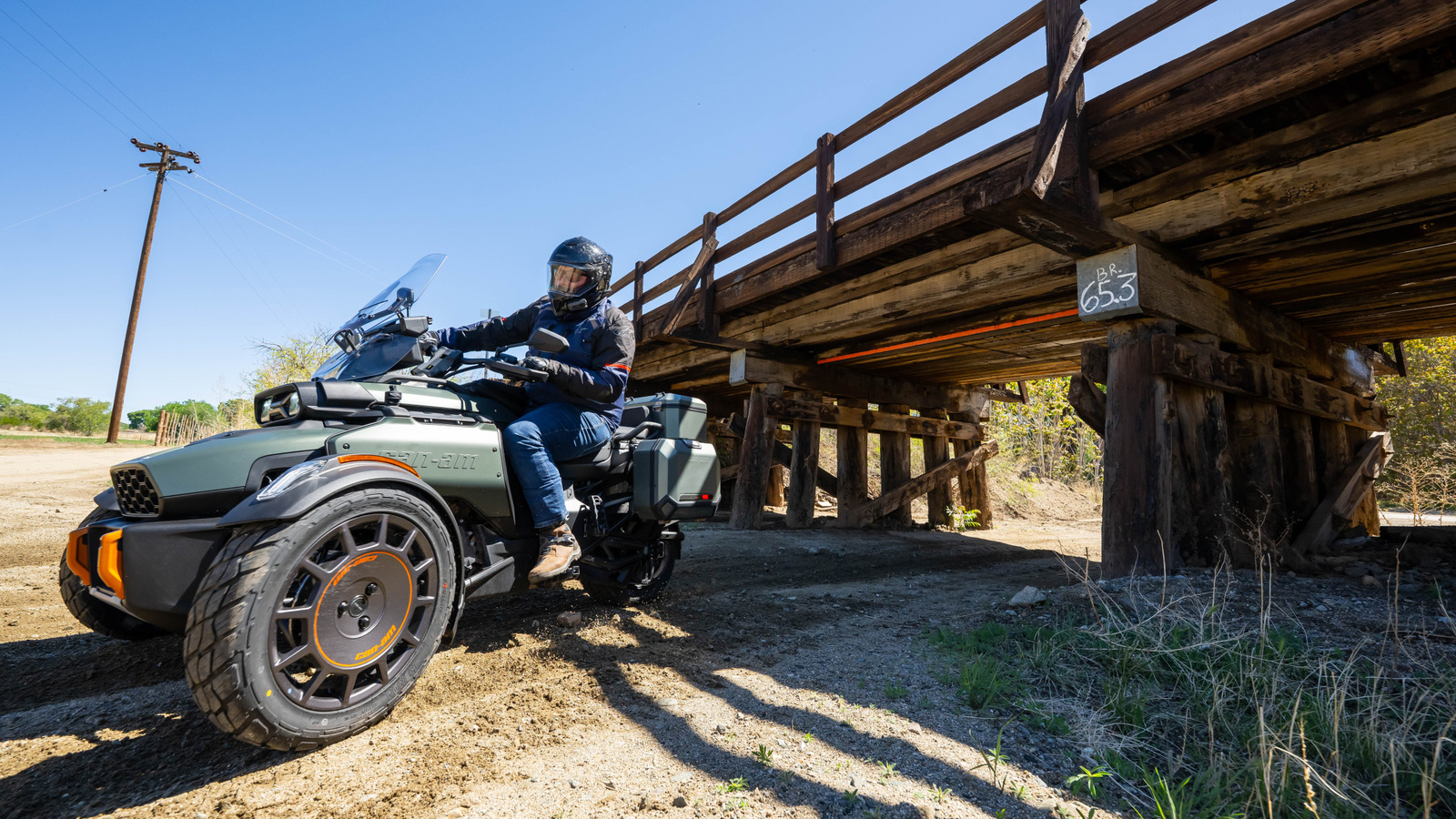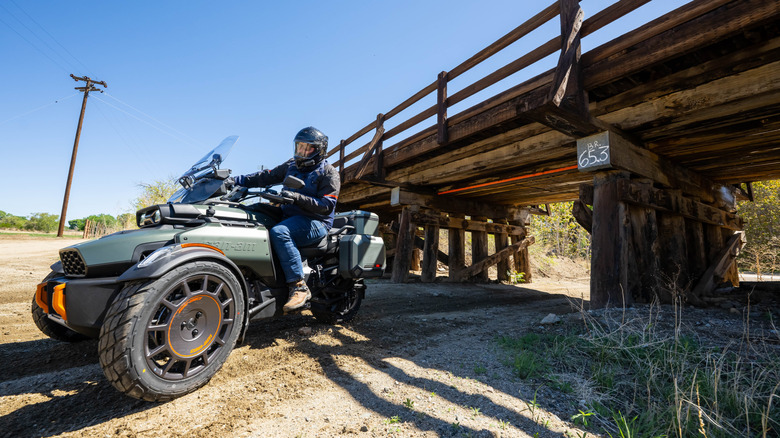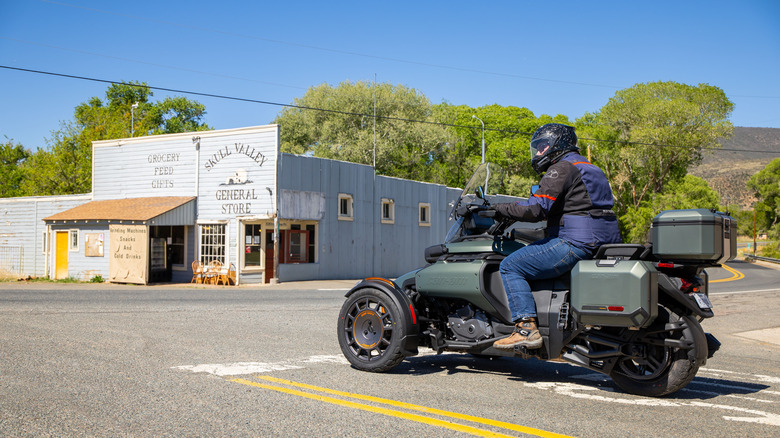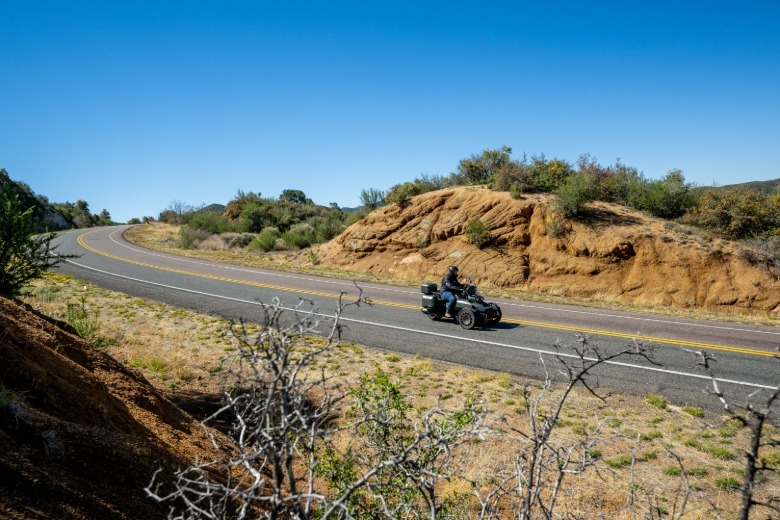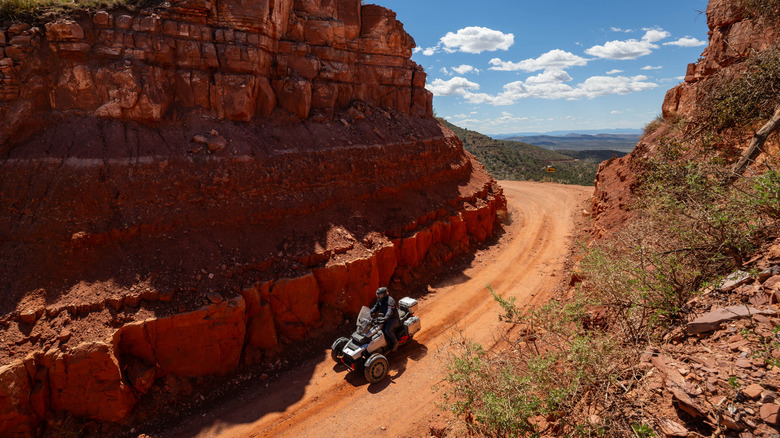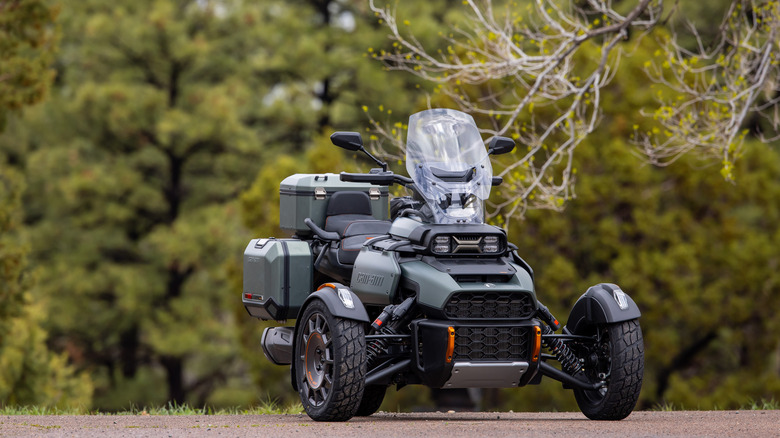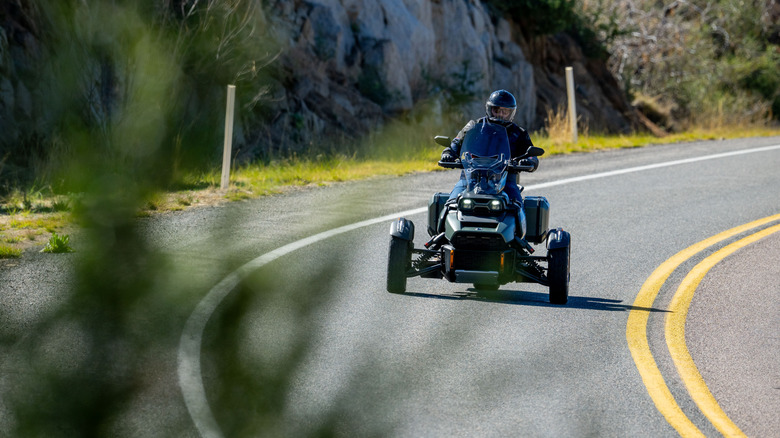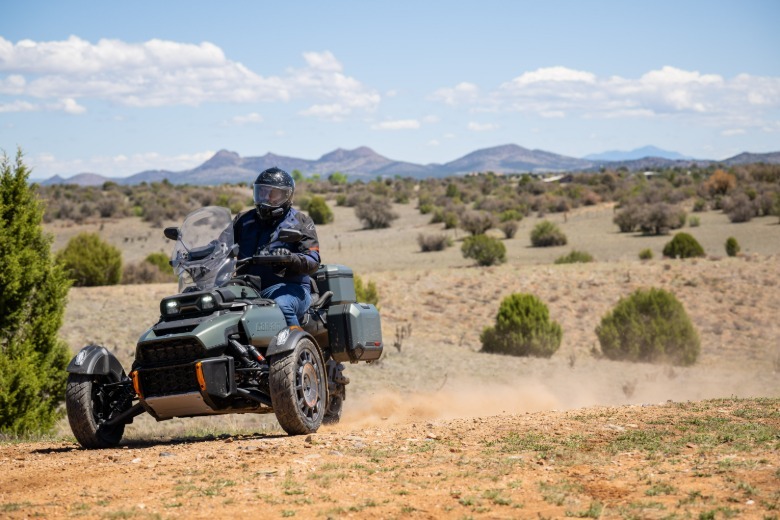Adventure touring is all the rage right now with every motorcycle brand rushing to out-develop each other in the big tall bike space. So-called ADV bikes are great because the extra suspension travel and large wheels means a reasonably cushy ride on the crumbling roads of our failing infrastructure, and good capability on dirt roads or trails, whether you need it or not. Even if you want the rugged adventure aesthetic and never plan to use it for more than riding to Starbucks, there’s probably an adventure machine out there for you. The problem, however, is that adventure bikes are tall and heavy, making them unwieldy for new riders and the vertically lacking.
Can-Am built the adventure-focused Canyon as a way to make the ADV segment a bit more accessible to a wider variety of riders, making the bike more comfortable for young riders, female riders, and people more comfortable with the way a car drives than the way a bike rides. If you’ve never ridden the dirt road path before and you find a BMW GS or Harley-Davidson Pan America intimidating, the Canyon is waiting for you to discover it. This unflappable machine is far more likely to stay upright in the dirt than anything with two-wheels, it employs a button-shift transmission so you don’t have to get used to modulating a clutch, and the brakes on all three wheels are controlled by a single right foot pedal to make the experience even more car-like.
Full Disclosure: Can-Am invited me out to Arizona, fed me and put me up in a nice hotel. I was treated to a beautiful day of riding in the mountains in the Prescott National Forest.
What is the Canyon about, anyway?
The Canyon looks like the kind of machine a future civilization would use to explore the face of a far-off planet. The two lower trims, Canyon and Canyon XT, are only available in silver, while the top-of-the-line Redrock model is only available in the metallic green shown here. It’s an easy-to-ride soft roader three-wheel thingy powered by the deep baritone of the standard 1.3-liter 3-cylinder Rotax 1330 Ace engine, making 115 horsepower. Power goes to the single rear wheel through a semi-automatic 6-speed transmission. At 1,000 pounds without a rider, the Canyon isn’t exactly the quickest or nimblest thing on the road, but it certainly isn’t sitting around.
The Canyon is based on Can-Am’s popular Spyder three-wheel street vehicle, cribbing the chassis but with new suspension and unique bodywork. The new machine is much taller, with 6.8 inches of ground clearance and higher approach angles thanks to the front wheels mounted all the way forward on the chassis. With 10 inches of suspension travel up front and 9 inches in the rear, the Canyon’s suspension has been engineered for the dirt. To further accentuate the adventure-ness, Canyon gets a standard adjustable windshield, handlebar risers, anti-slip foot pegs, and more luggage mounting options than you could ever need. It’s pretty standard adventure fare, and when it’s all covered in mud and dust it passes the ADV vibe check.
What does it ride like?
The Canyon is significantly more stable and faster by a mile than any two-wheeled adventure bike when the pavement drops away and the earth underneath is revealed, potentially even rivalling a good dirt bike. Without the fear of falling off or low siding a motorcycle, dirt road and trail curves are taken at near-car speeds, straining shoulders and thighs to hold fast against the centripetal forces enacted on your torso. Depending on how often you work out, the Canyon might have more grip on the road than you have on it. Unfortunately, in this case, I did not correlate speed with riding enjoyment.
From the first few seconds in the saddle to the end of a couple hundred mile ride, I never felt fully comfortable aboard the Canyon. By dint of its two front wheels, near car-width, “adventure tires,” and handlebar steering, the front end of this bike feels jumpy and twitchy, even while travelling in a straight line. The bike does feel more comfortable and composed when ridden on dirt, with a slippery terrain taking some of the edge away, but that brings separate problems. The Canyon loses some trail riding fun in favor of safety, as the contraption’s stability control is equal parts aggressive and intrusive. Dial in one degree too much steering angle while braking and the Canyon will apply a stab of extra clamping force to one of the front wheels, seemingly at random. More than once did I find this abrupt clamping force leading to a mid-corner panic moment, which made the ride all the more uncomfortable.
I think my biggest gripe is simply found in the difficult-to-modulate foot pedal braking. Especially in riding boots, getting finesse on the foot-only braking feels slightly difficult. In street riding at least 90% of my braking is done with the right-hand actuated front brakes, but with all three brakes linked and activated by my right foot, it felt like I wasn’t slowing enough at partial engagement, then nearly locking up as I dipped my toe lower.
What’s the upside?
From a tech perspective this thing is at the very top of the pile. A beautiful 10.25-inch touchscreen display with integrated Apple CarPlay is the centerpiece, and it works really well, while feeling and reacting better than most car infotainment systems. With ride modes, traction control, stability control, a reverse gear, optional heated grips and seats, optional active suspension, and tons of storage options, this is about as technologically advanced as any motorcycle has ever been. I would have liked to have seen radar cruise control, especially at this price point, but so it goes. I don’t think any rider would find this particularly lacking in the whizbangery department.
The Canyon looks and feels of a high quality with serious fit and finish. I’m not one for matte finishes, but the Can-Am wears it well, and looks the part. It seems like the kind of quirky machine a member of the Canadian military would ride during a training drill or something, which has its plusses and minuses. The wheels, particularly on the Redrock model (above) are old-school rally cool. From a vibes and aesthetics point of view, the Canyon really works for me, which seems to be the main reason people buy ADV bikes in the first place.
I get why the Canyon exists, and I hope it completes its mission statement of making adventure riding more accessible. If you’re the kind of person who wants to go on the rarely-beaten trail with your ADV riding buddies, but you don’t feel comfortable in a tall saddle, or find yourself too afraid of falling, this can work wonders for you. Unfortunately, I found it to have none of the riding fun of a two-wheel adventure bike and only a fraction of the safety of a car. If three wheels is your kink I’m not here to yuck your yum, but to my palate it tastes watered down and a little bitter.
It costs how much?
For the experience I had aboard the Canyon, I unfortunately can’t justify why it costs as much as it does. I did not get an opportunity to ride a $25,299 base model Canyon, as Can-Am did not bring any to the test. It seems that if you aren’t typically riding with a passenger or carrying a ton of gear with you, the base model might do just about everything you’d need it to do.
Step up to the $29,799 Canyon XT and you’ll get skid plates, a more comfortable pillion seat, self-leveling air preload rear suspension, a full spate of aluminum cases, and heated grips. I spent a good part of the day riding the XT model and it was perfectly serviceable on a hundred miles of back country mountain dirt road. I’m not sure it’s worth the jump to a Redrock model, if you’re committed to buying a Canyon.
The Can-Am Canyon Redrock gets a unique green colorway, a standard reverse camera, and most-importantly KYB’s semi-active Smart-Shox suspension. I rode one for the first half of the day in Arizona and did find the different modes to have a noticeable effect on the suspension, but the street modes felt jumpier and more frenetic still than the standard fare, and the normal and rally modes felt too wobbly and rolly for any kind of fun riding on pavement. It felt a lot more at home in the dirt, that’s for sure, but never delivered the confidence I hoped for. Perhaps I’m being goldilocks here, but the porridge didn’t have a just right.
I’m typically a fan of quirky Canadians, but like their poutine, I think this one had too much gravy on it for my liking. If I’m going dirt riding in a Can-Am product, it’s going to be one of the company’s incredible side-by-sides.


